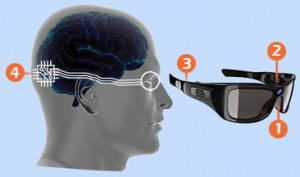The Bionic Eye
We often get asked about developments in the bionic eye project. Here is some of the latest research and development on the bionic eye project in Australia:
Researchers and scientists from Australia’s Monash University are preparing to implant a new version of the bionic eye in 2016. The thing that is a little different about this version of the bionic eye is that the system does not use the eyes at all. Previous models of the bionic eye have used a chip inserted on to the retina at the back of the eye, but this version does not use the eye at all.
The direct to brain bionic eye being developed at Monash University uses a digital camera mounted on glasses that the patient wears (1). Inside the glasses, an eye movement sensor will direct the camera (2). A digital processor and wireless transmitter sit on the side of the glasses frame (3). The information received by the processor on the glasses frame is then transmitted to a chip inserted in the patients occipital cortex area of the brain, and will directly stimulate the patients visual cortex (4).
The direct to brain bionic eye is being developed to help people with visual impairment caused by macular degeneration, glaucoma, trauma, and certain other ocular diseases.
The bionic eye projects around the world are still in the early development phases, and the images produced by these systems are certainly not clear images like what a healthy eye sees. It is hoped that with advancements in technology in the coming years, that there will be improvements to the image quality produced by these bionic eye projects. The bionic eye continues to be a very exciting development and will potentially change the future for people living with blindness and visual impairment.
For further information on the Monash University direct to brain bionic eye project, please follow this link:
http://www.monash.edu.au/bioniceye/technology.html
For information about who is suitable for the direct brain to eye bionic eye, and to see whether you may qualify to take part in the trial, please click on this link:


